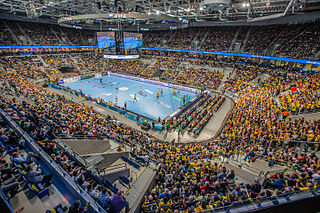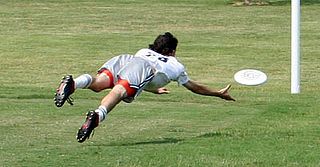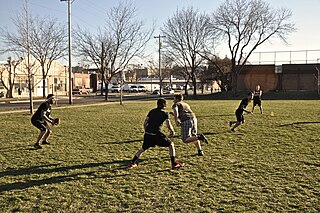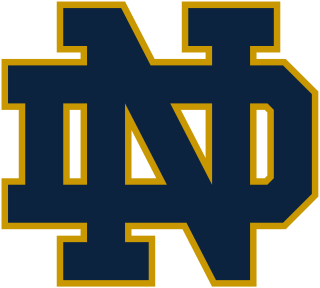
Canadian football, or simply football, is a sport in Canada in which two teams of 12 players each compete on a field 110 yards (101 m) long and 65 yards (59 m) wide, attempting to advance a pointed oval-shaped ball into the opposing team's end zone.

The end zone is the scoring area on the field, according to gridiron-based codes of football. It is the area between the end line and goal line bounded by the sidelines. There are two end zones, each being on the opposite side of the field. It is bordered on all sides by a white line indicating its beginning and end points, with orange, square pylons placed at each of the four corners as a visual aid. Canadian rule books use the terms goal area and dead line instead of end zone and end line respectively, but the latter terms are the more common in colloquial Canadian English. Unlike sports like association football and ice hockey which require the ball/puck to pass completely over the goal line to count as a score, both Canadian and American football merely need any part of the ball to break the vertical plane of the outer edge of the goal line.

Handball is a team sport in which two teams of seven players each pass a ball using their hands with the aim of throwing it into the goal of the opposing team. A standard match consists of two periods of 30 minutes, and the team that scores more goals wins.

Ultimate, originally known as ultimate frisbee, is a non-contact team sport played with a disc flung by hand. Ultimate was developed in 1968 by Joel Silver in Maplewood, New Jersey. Although ultimate resembles many traditional sports in its athletic requirements, it is unlike most sports due to its focus on self-officiating, even at the highest levels of competition. The term "frisbee" is a registered trademark of the Wham-O toy company, and thus the sport is not formally called "ultimate Frisbee", though this name is still in common casual use. Points are scored by passing the disc to a teammate in the opposing end zone. Other basic rules are that players must not take steps while holding the disc, and interceptions, incomplete passes, and passes out of bounds are turnovers. Rain, wind, or occasionally other adversities can make for a testing match with rapid turnovers, heightening the pressure of play.

Touch football is an amateur variant of American football and Canadian football. The basic rules are similar to those of the mainstream game, but to end a down, the person carrying the ball need only be touched, instead of tackled, by a member of the opposite team. This rule change gave the game its name, to differentiate it from other variants. It is similar to street football, another amateur variant, however in street football full contact is allowed.

In sport, a goal may refer to either an instance of scoring, or to the physical structure or area where an attacking team must send the ball or puck in order to score points. The structure of a goal varies from sport to sport, and one is placed at or near each end of the playing field for each team to defend. Sports which feature goal scoring are also commonly known as invasion games.

A down is a period in which a play transpires in gridiron football. The down is a distinguishing characteristic of the game compared to other codes of football but is synonymous with the 6 "tackle" rule in rugby league. The team in possession of the football has a limited number of downs to advance ten yards or more towards their opponent's goal line. If they fail to advance that far, possession of the ball is turned over to the other team. In most situations if a team reaches their final down, they will punt to their opponent, which forces their opponent to begin their drive from further down the field; if they are in range, they might instead attempt to score a field goal.
Strategy is a major part of American football.

Gameplay in American football consists of a series of downs, individual plays of short duration, outside of which the ball is or is not in play. These can be plays from scrimmage – passes, runs, punts or field goal attempts – or free kicks such as kickoffs and fair catch kicks. Substitutions can be made between downs, which allows for a great deal of specialization as coaches choose the players best suited for each particular situation. During a play, each team should have no more than 11 players on the field, and each of them has specific tasks assigned for that specific play.
In sports, offense or offence, known as attack outside of North America, is the action of attacking or engaging an opposing team with the objective of scoring points or goals. The term may refer to the tactics involved in offense, or a sub-team whose primary responsibility is offense.
Hot Box is a non-contact team sport which is similar to ultimate, but played on a smaller field and with fewer players. Like ultimate, the object of the game is to score points by passing the disc into the end zone; however, in Hot Box there is generally only one end zone and it is of much smaller size than an Ultimate end zone. In this way, hot box is a "half-court" variant of ultimate. Because of these reduced requirements, it is often played when not enough players are available to play ultimate.
Flickerball is a group sport played with an American football in similar situations to dodgeball, such as Gym Class/PE classes. It is played in a group of 6 to 40 players who are equally divided into two teams. The teams separate on opposite sides of an area such a gymnasium, parking lot, or field. The game is unstructured in terms of what constitutes or if there will be outs and the length of play nor time-outs. There are many rules and the game is structured most similarly to Ultimate Frisbee. One notable exception is that any shot on goal results in the ball going out of bounds which results in an automatic change of possession. This rule should mitigate wild shots hoping for statistical points.

Street football, also known as backyard football or sandlot football, is an amateur variant of American football primarily played informally by youth. It features far less equipment and fewer rules than its counterparts and, unlike the similar touch football, features full tackling.
The following terms are used in water polo. Rules below reflect the latest FINA Water Polo Rules.

A comparison of American football and rugby union is possible because of the games' shared origins, despite their dissimilarities.
A comparison between American football and rugby league is possible because of their shared origins and similar game concepts. Rugby league is arguably the most similar sport to American football after Canadian football: both sports involve the concept of a limited number of downs/tackles and scoring touchdowns/tries takes clear precedence over goal-kicking.

The 2011 Wisconsin Badgers football team represented the University of Wisconsin–Madison in the 2011 NCAA Division I FBS football season. The Badgers, led by sixth-year head coach Bret Bielema, are members of the Leaders Division of the Big Ten Conference and played their home games at Camp Randall Stadium. They finished the season 11–3, 7–2 in Big Ten play to be Leaders Division co–champions with Penn State. Due to their head-to-head win over Penn State, the Badgers represented the division in the inaugural Big Ten Championship Game where they defeated Legends Division champion Michigan State 42–39 to become Big Ten Champions. They were invited to the Rose Bowl for the second consecutive year where they were defeated by Oregon 38–45.

The 2013 Bowling Green Falcons football team represented Bowling Green State University in the 2013 NCAA Division I FBS football season. Through the 2013 MAC Championship Game, the Falcons were led by fifth-year head coach Dave Clawson. On December 10, Clawson left to become the new head coach at Wake Forest; the school named special teams coordinator Adam Scheier as interim head coach for the 2013 Little Caesars Pizza Bowl.

The 2018 Notre Dame Fighting Irish football team represented the University of Notre Dame in the 2018 NCAA Division I FBS football season. The team was led by head coach Brian Kelly, who was in his ninth season at Notre Dame, and played its home games at Notre Dame Stadium in Notre Dame, Indiana. The Fighting Irish competed as an independent.













